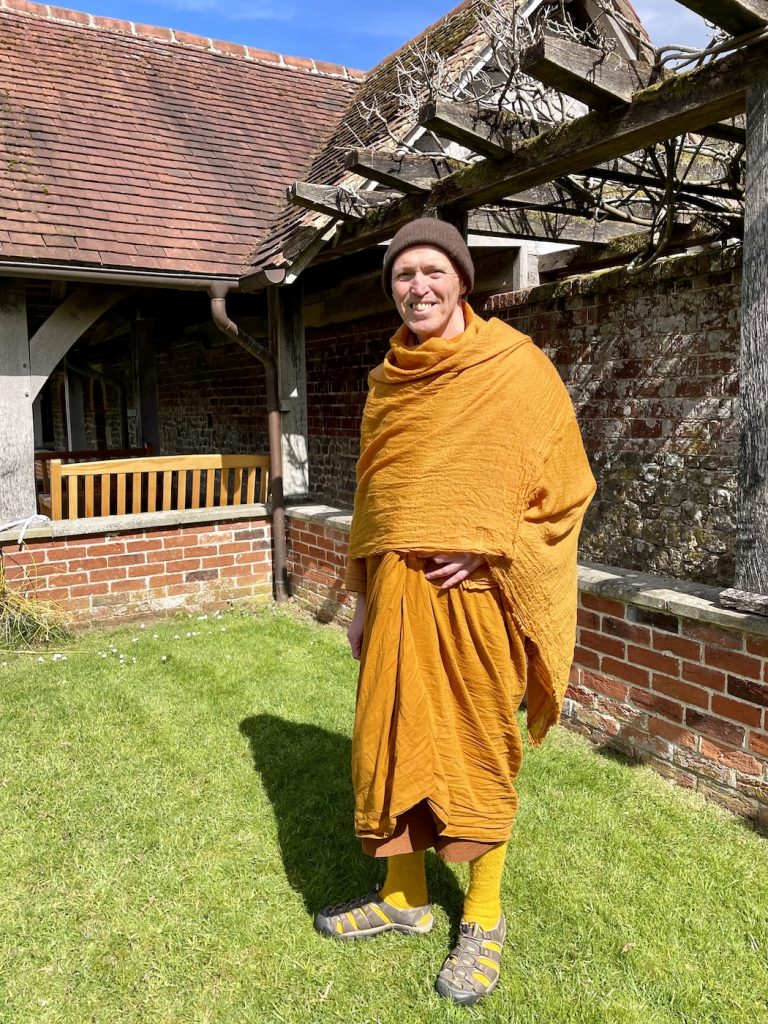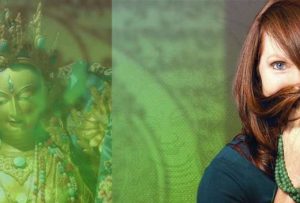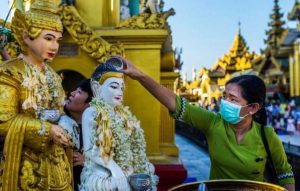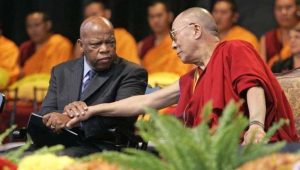
The Thai Forest Tradition, exemplified by the revered Thai master Ajahn Chah (1918–92), has had roots in the United Kingdom since the late 1970s. Ajahn Chah played a key role in planting the seed of Theravada Buddhism in the West, the maturing fruit of which continues to be nurtured by his lineage today.
London-born Ajahn Sucitto was ordained in Thailand in 1976. He returned to his native Britain in 1978 and became student of Ajahn Sumedho, Ajahn Chah’s most senior Western disciple. Led by Ajahn Sumedho, Ajahn Sucitto and a small group of monastics established Watpa Cittaviveka, also known as Chithurst Forest Monastery, in the English county of West Sussex. Having helped to establish a further two monasteries in England, Ajahn Sucitto was appointed abbot of Watpa Cittaviveka in 1992, a post he held until 2014.
Ajahn Sucitto is a prolific Dhamma teacher and the author of numerous texts and books on the Buddha’s teaching. He has also been instrumental in the founding of a community of female renunciates in Britain known as the Siladhara Order.
Buddhistdoor Global recently had an opportunity to speak with Ajahn Sucitto at Watpa Cittaviveka, nestled in the deep greens and browns of the West Sussex countryside, who shared his thoughts on the growth of Buddhism in Britain and in the West.
Buddhistdoor Global: Ajahn Sucitto, thank you for sharing your time with us. I wonder if, to begin, you might talk a little about the history of the Thai forest tradition in Britain and your role in its taking root here?
Ajahn Sucitto: I spent about three years in Thailand, from 1975–78 and I returned to England in 1979. There was a small monastic group in Britain at that time. There were the Thai temples and Sri Lankan temples, and there was a tiny group in Hampstead, which was a branch set up by the English Sangha Trust, which itself was established in 1956 to facilitate monastic training in Britain and which is now the charity that supervises Cittaviveka.
The English Sangha Trust invited Ajahn Chah to send a disciple over, which was Ajahn Sumedho. So he came over and brought three other monks with him. That was the seed. I turned up a year or so later and joined that group in Hampstead in 1978.
Cittaviveka has been established since 1979, which makes this about its 43rd year. I’ve been here not all of that time, but I came here in 1979 and was here for about five years. Then I went to start Amaravati Monastery in the north of London. I was there for eight years, then I returned to Cittaviveka.
I’ve been here most of the time since, but I do a lot of teaching, which involves traveling, because this isn’t really a teaching center. So I teach retreats in various places—Africa, Australia, New Zealand, America, Asia, Europe, all over the world, basically.
Now, there are about six forest tradition monasteries in the UK, all stemming from Ajahn Chah, with about 60 or so monastics. Here at Cittaviveka, we’re about 9–10 bhikkhus and a couple of samaneras and some anagarikas—perhaps 18 altogether, currently. It can go as high as about 30, including lay residents.
BDG: Can you share any recollections of Ajahn Chah?
AS: He’s difficult to describe! [laughs] He was . . . other, you know? What’s a mountain like? What’s a great oak tree like? Massive! He could be very quiet and very strict; very stern and determined; humorous and playful; on the ball, with a lot of energy—tremendous determination and utterly committed.
It’s difficult to get across. You can read the books, but there are limitations to language that can’t capture the person in words—the depth, the silence, you know. Unfathomable. And yet he could be extremely . . . present. Very sharp. He could be fierce, yet at other times very kind. He could be very very kind and loving. It was the size of the person; although he was fairly small he was somebody who was bigger inside than outside. You had a feeling that whatever you said to him just went into this great vastness and disappeared. And then something came out of it back to you! [laughs]

BDG: As a Dhamma teacher in Britain, do you see the Buddhist teaching flourishing? Are more laypeople adopting and practicing Buddhism?
AS: Well, it depends what you mean by “Buddhism!” [laughs] They adopt some things! There’s a lot of interest in the kinds of meditation that stem from the Buddha. There are a lot of retreat centers and sitting groups all over the country that draw their practices from the teachings of the Buddha. You can find Zen, Tibetan, and Theravada traditions. In terms of Theravada, there are quite a few Thai and Sri Lankan temples, so you have “temple Buddhism.” And then you have retreat center Buddhism. And the two don’t necessarily meet. We tend to cross over because, obviously, I teach meditation, so I also visit retreat centers to teach. Other places are much more associated with supporting an expatriate Asian community—the Thais particularly.
But there’s a lot of Buddhism in the UK now. There are over 30 Thai temples alone, and then there are small Sri Lankan viharas all over the country that I don’t even know about. And that’s just Theravada. Then there are the Tibetans and various Zen and Chan fellowships, and then you’ve got various organizations, charities, and trusts. So there’s a lot going on. In most cities and towns you’ll find some sort of Buddhist meditation group.
During the COVID-19 lockdowns, at the most intense point, no guests were allowed here at the monastery. People could bring food but they had to drop it off outside the house, which lasted for a while. Then we loosened it a bit so that people could come into the meditation hall and use the facilities. Residential guests came for up to two months because they had to quarantine—there’s not much point in staying for only two weeks if you have to observe a 10-day quarantine period. So we allowed people to come for two months.
But of course there were no public events, so we started to go online a lot more. It was quite successful, but it took a bit of doing because we’re not very tech-savvy. But people responded to it very well; they loved it.
BDG: Do the same conditions exist here for temporary ordination, as we see in Thailand, for example?
AS: No, we don’t do temporary . . . I mean, sometimes they are temporary because people leave! [laughs] But the idea is you won’t! The idea is you’ve got to take five years, otherwise why bother? Here, you see, there’s strong emphasis on training and lifestyle. So when you first come, you can’t become a monk anyway; you’ve got to become an anagarika for at least a year. And after that, if you’ve done a year or so, we can consider whether you become a samanera. And then if everything’s ok, you can become a samanera for a year—at least, maybe longer. Then, if you really want to and everyone thinks you’re ready, you could become a bhikkhu. So it takes at least two years to even get to the door. And if you want to come in as a bhikkhu, it’s a serious commitment that requires a lot of support and a lot of attention.
Now, in many Thai monasteries you can often rock up and become a bhikkhu in within a week [laughs] and disrobe the next week, because it’s considered a meritorious thing to do. You know, you live in a good way, observe the precepts, live a noble life, and you do that for a week then leave, and good for you. And that’s quite understandable, but we don’t do that here. It tends to dilute the intensity and solemnity of the training—and of course you can’t master this in a week. Here there’s a lot of emphasis on conduct and renunciation.
BDG: Is there an aspect of socially engaged Buddhism within the Forest Tradition?
AS: Well, it depends what you mean by “engaged.” We probably don’t count very heavily in that particular “box” of engaged social activists. The idea is that a samana lives on the edge of the “village” and doesn’t come in. You go out of the village to meet the monk, who doesn’t get involved in politics or worldly affairs, so he’s always non-partisan and therefore people of different persuasions can come to talk to him. That’s the classic model. Because once monks become “involved,” sooner or later the corruption starts to creep in.
Our engagement is principally through a lot of teaching online. We publish books on Dharma ethics and most recently a huge book on Buddhism and the environment that I wrote. But it’s also up to each individual—I’ve been a monk now for about 45 years, so after about 20 years or so you focus on doing your own thing. I’ve written about 15 books, for example.
BDG: Do you feel confident about the outlook for Buddhism in the West?
AS: Oh yes. I mean, it will shift and it will change. It’s bound to morph—Buddhism always morphs as it goes into a new culture. It will start to shed its skin and evolve into something else, that’s always the case.
For example, looking at Vajrayana, there’s a huge amount of Tibetan culture and Tibetan shamanism infused into it. In the case of Theravada, it’s a variation on early Buddhism, which started occurring in India and really shifted when it went to Sri Lanka. And so it’s not primary Buddhism, which is extinct. Then it went to China, which of course is very different. And the Tibetan form came in through the beginning of the Vajrayana in Nalanda and Odantapuri in Bengal, where they were teaching a lot of the more tantric traditions. So it went up into Tibet in the eighth century onwards, and took all that later Indian culture and mixed it up with central Asian animism and Bon and so on, and we ended up with something called Tibetan Buddhism. [laughs]
The monastic form tends to hold things more, because it becomes formalized, but once you take Buddhism out of its envelope, change happens. Buddhism in America, for example: in some cases a Thai person might hardly recognize it as Buddhism. Once you strip off the monastic skin, you start dealing with things like Buddhism and social justice, gender diversity, and Buddhism becomes much more kitted out to American needs and the American voice.

BDG: Can you offer any advice for laypeople living in modern consumerist societies to help them find the time and space in their lives to practice more deeply?
AS: Well, this is what the word “renunciation” is all about. You’ve got to declutter and get lean, pare down. Everything that you consume consumes you—you know, you go to the car and it’s saying “money, money, money, money. . . .” [laughs] So you’ve got to get rid of as much as possible to get lean, so that you’ve got the least overheads. And then you’ve got to do the same with your time.
It’s not really monasticism as such, but renunciation is one of the three primary skillful inclinations for anybody. Because, you know, consumerism is so consuming—there’s always more, newer, more powerful, more exciting, different, better. . . . And, instead, if you start to go the other way, then you find more space, more time. But it does mean you’ve go to go without. Of course, the beauty of it is that we can! You get used to it and it becomes the new normal, without all the noise and clatter and burdens. Live lean!
See more
Ajahn Sucitto
Cittaviveka: Cittaviveka Buddhist Monastery
Forest Sangha
Related features from BDG
Ajahn Sucitto, Down to Earth
Marking the 125th Birth Anniversary of Ven. Ananda Maitreya in England



















I know this is from an article shared from a dear friend. I hope it reaches there!!